Recently I have been looking at improving my 3D prints, and after some searches around, SeeMeCNC (the manufacturer of my longest running 3D printers), was selling this Android-based tablet called MatterControl Touch. Based on the literature on the website (http://seemecnc.com/products/mattercontrol-touch-tablet) the ease of use and relatively fast process of starting a new print was an appealing factor in my decision to purchase the MatterControl Touch earlier this week.
Based off of the software of the same name, the tablet takes over the role of downloading, slicing/repairing the .STL files and ultimately the handling of the GCode to the printer. After some initial trial and error, I printed the default test print (a square object roughly 1cm3). The initial test print had a warping issue on one of the corners, which I later determined was from the printer set too fast of a print speed.
Since then I have successfully printed eight different objects; Five (5) coasters from the NES 8bit Coaster Set (http://www.thingiverse.com/thing:104371), a tablet holder (http://www.thingiverse.com/thing:303952) and the latest print (http://www.thingiverse.com/thing:403031), all came out extremely well with little sanding required. Below is one of the prints at extremely close up.

Since I received my unit on Wednesday, I have been very impressed with the ease of use of the software, as well as the speed of which I can find a new item on Thingiverse, download it, slice/repair the STL, generate the GCode, and finally start printing within 10 minutes.
As I do more of YouTube videos of each unique Thingiverse item, the speed of which I can start a new print, will easy pay for itself in no time.
If you are new to 3D printing, and you have never used Slic3r or Cura, I highly recommend using this tablet, as a starting block.
If you would like to see more content regarding the MatterControl Touch, be sure to leave a comment here!





















.JPG)
.JPG)
.JPG)
.JPG)
.JPG)